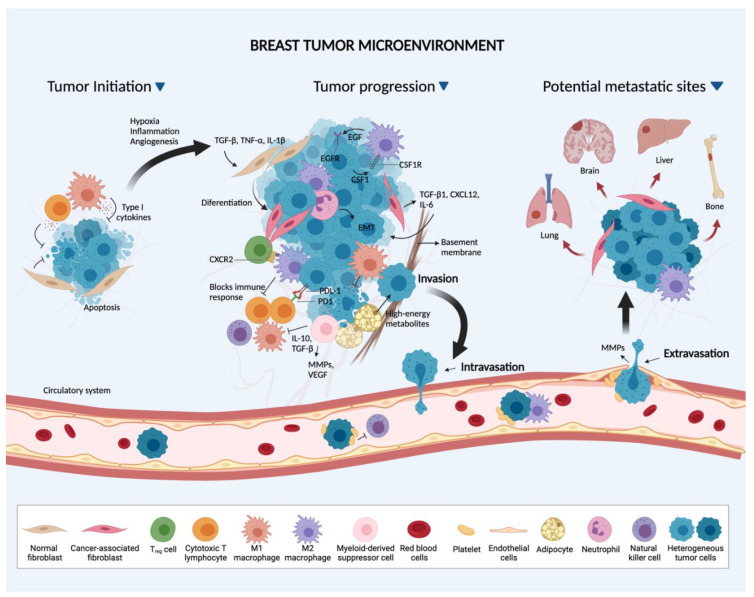Figure 1.
The tumor microenvironment (TME) and breast cancer progression. At the onset of tumor initiation, the developing tumor is exposed to growth-suppressive signals from the inflammatory process, which is primarily modulated by cytotoxic T-lymphocytes, M1 macrophages and fibroblasts. The BC cells overcome these mechanisms by educating host stroma cells to acquire pro-tumorigenic features. Cytokines (TGF-β, IL-1β and TNF-α) released from the inflammatory process then modulate the differentiation of normal fibroblasts to cancer-associated fibroblasts (CAFs). The latter, in turn, secrete extracellular matrix proteins and soluble factors (TGF-β, CXCL12, IL-6) that stimulate epithelial to mesenchymal transition (EMT), tumor growth and progression. Neutrophils can induce EMT and promote tumor progression through cytokines release. Adipocytes secrete high-energy metabolites to fuel tumor growth. Tumor-associated macrophages (primarily M2 macrophages) support various processes within the TME, including BC growth and invasion by secreting pro-tumorigenic cytokines and growth factors. During tumor expansion, activated cytokines in the environment (CXCL5-CXCR2, TGF-β) stimulate the recruitment of regulatory T cells (Treg) and myeloid-derived suppressor cells (MDSCs) which disrupt immune surveillance by inhibiting cytotoxic T lymphocytes, M1 macrophages and natural killer cells. BC cells can also escape immune surveillance by overexpressing the PD-L1 ligand. Such orchestrated events in the primary tumor allow tumor cells to acquire a mobile and invasive phenotype. Secreted factors (MMPs, VEGF) further facilitate tumor cells intravasation into the circulation. There, BC cells interact with platelets and M2 macrophages to support their survival by inhibiting immune recognition. Platelets escort tumor cells to the secondary sites, where it interacts with endothelial cells and promote extravasation. The preferred site of metastasis can be influenced by the subtype of the BC (Created with BioRender.com, accessed on 12 September 2021).

